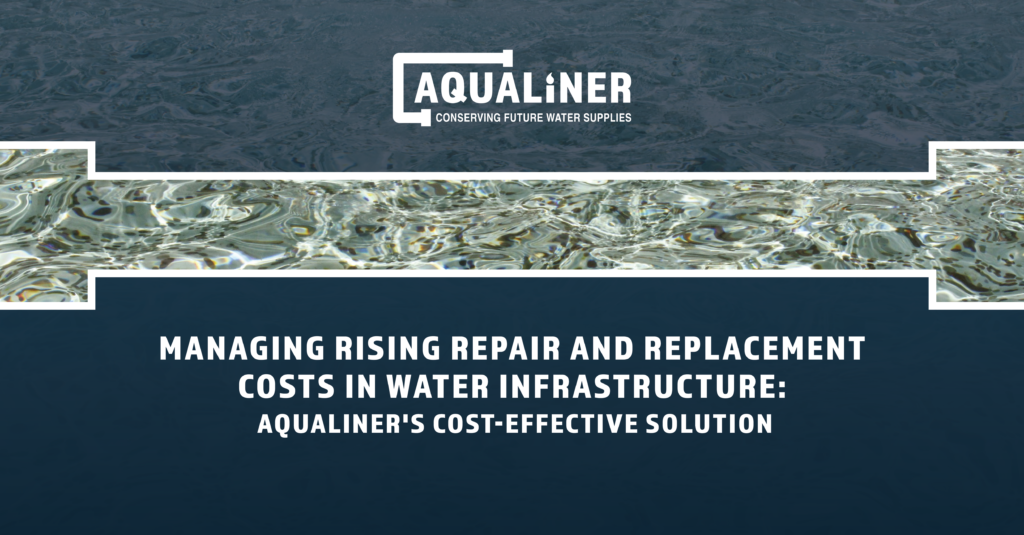Managing Rising Repair and Replacement Costs in Water Infrastructure: Aqualiner's Cost-Effective Solution

Managing Rising Repair and Replacement Costs in Water Infrastructure: Aqualiner’s Cost-Effective Solution
As water distribution systems age, municipalities and utilities face a growing challenge: managing the rising costs of repairing and replacing deteriorating infrastructure. With tightening budgets, increasing demand, and the need to maintain reliable service, the financial burden of addressing ageing water pipes is becoming unsustainable for many communities.
This blog will explore the financial pressures associated with water infrastructure repairs and replacements and how Aqualiner’s Pipe Renewal technology provides a cost-effective solution.
The Problem: Escalating Costs of Water Infrastructure Repairs and Replacements
The global water infrastructure desperately needs modernisation, but the cost of doing so has steadily increased. Several factors contribute to this rise in costs:
- Increased Frequency of Repairs: As pipes continue to age, leaks, bursts, and other failures become more frequent. Utilities are often forced to respond to these failures with emergency repairs, which are typically more expensive than planned maintenance.
- Rising Material and Labour Costs: The cost of raw materials like steel, copper, and concrete has been steadily increasing. Additionally, labour shortages in the construction and utilities industries are driving wages higher, making repairs and replacements more expensive.
- Disruption to Communities: Traditional pipe replacement methods often involve digging up streets and disrupting traffic, businesses, and daily life. These disruptions lead to indirect costs, such as compensation for affected businesses, loss of revenue, and public dissatisfaction.
As Lord Darren Mott, adviser to Aqualiner, explains, “The financial pressure on utilities to maintain ageing infrastructure is immense. Every time a pipe fails, it’s not just a physical break—it’s a financial one. With rising costs, utilities are struggling to keep up.”
Aqualiner’s Solution: Reducing Costs with Enhanced Pipe Longevity
Aqualiner offers a cost-effective alternative to the traditional repair and replacement process. By focusing on extending the life of existing infrastructure, Aqualiner’s pipe renewal technology helps utilities avoid the high costs associated with complete pipe replacement while improving long-term performance.
Here’s how Aqualiner reduces costs:
- Trenchless Installation: Aqualiner uses trenchless technology, which rehabilitates pipes without requiring extensive excavation. This minimises the labour and material costs typically associated with digging up and replacing entire pipelines. “By avoiding disruptive excavation, we can save communities significant time and money,” says Lord Mott. “The financial and social costs of digging up streets for weeks at a time are simply too high.”
- Longer Pipe Lifespan: Aqualiner’s internal pipe linings are designed to extend existing pipes’ lifespan significantly. By reinforcing the interior of the pipes, Aqualiner prevents further deterioration and corrosion, reducing the need for frequent repairs. This proactive approach translates into long-term cost savings, as utilities can delay replacing entire network sections.
- Lower Maintenance Costs: With Aqualiner’s durable and corrosion-resistant linings, utilities can reduce the number of emergency repairs and ongoing maintenance needs. Fewer unexpected failures mean fewer expensive repairs, saving utilities money over time.
The Financial Benefits of Proactive Investment
One key advantage of Aqualiner’s pipe renewal technology is that it allows utilities to take a proactive approach to infrastructure management. Rather than waiting for pipes to fail, utilities can invest in rehabilitation now to prevent costly emergency repairs later. This kind of foresight can lead to significant long-term savings.
“Proactive investment in water infrastructure is the only way to break the rising costs cycle, ” says Lord Mott. “By choosing smart, long-term solutions like Aqualiner’s, utilities can protect both their water systems and their budgets.”
Conclusion
The rising cost of repairing and replacing ageing water infrastructure is an increasingly unsustainable burden for utilities and communities alike. With frequent pipe failures, escalating labour and material costs, and disruptions to daily life, the need for a more cost-effective solution is clear. Aqualiner’s technology provides that solution, reducing repair and replacement costs while extending the life of existing infrastructure.
By investing in trenchless technology and durable pipe linings, utilities can save money, reduce maintenance costs, and protect their systems for decades to come. As Lord Mott said, “it is far greater than prevention. Aqualiner is helping communities get ahead of the problem and the rising costs.”
